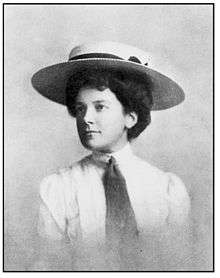Sailor hat

A sailor hat is a brimmed straw hat similar to those historically worn by nineteenth century sailors before the sailor cap became standard. It is very close in appearance to the masculine boater,[1] although "sailors" as worn by women and children have their own distinct design, typically flat-crowned, wide-brimmed and with a dark ribbon band extending into streamers hanging off the brim.[2] Such hats could also be made in felt as an alternative to straw.[3]
Origins
The sennit or straw hat formed part of the British naval uniform up until 1921 when it was formally discontinued by order on March 16, 1921.[4][5]
Fashion

The "sailor" was a standard form of fashionable headgear for women and children in the nineteenth and twentieth centuries. Children often wore it with sailor suits.[3] For women, the sailor became fashionable from the 1870s onwards, in a rather smaller form than its inspiration.[6] One 1870s variation on the style was the Marin anglais bonnet, which added extra trimmings of flowers and ribbons to the sailor hat form.[7] In most decades since the 1870s the sailor, or variations thereof, has been in fashion, or a staple form of headgear. One popular variation was the "short-back sailor", distinguished by its large broad flat brim, narrowing sharply (sometimes to nothing) in the back, and frequently worn at an upwards tilt.[8]
The sailor hat was a key part of Chanel's trademark 'little boy' look that she popularised in the 1920s and revived in 1954 for her comeback collection.[9][10]
References
- ↑ Lewandowski, Elizabeth J. (2011). The complete costume dictionary. Lanham, Md.: Scarecrow Press, Inc. p. 88. ISBN 9780810877856.
- ↑ Severa, Joan L. (1995). Dressed for the photographer : ordinary Americans and fashion, 1840-1900. Kent, Ohio: Kent State Univ. Press. pp. 108, 158. ISBN 9780873385121.
- 1 2 Amphlett, Hilda (2003) [1974]. Hats : a history of fashion in headwear. Mineola, NY: Dover Publications. ISBN 9780486427461.
- ↑ Brassey's Naval and Shipping Annual. William Clowes and Sons, Limited. 1921. p. 24.
As regards naval ratings, the most interesting change was the abolition of the sennet or straw hat, by an order dated March 16.
- ↑ "NMM: Search the Collections.Royal Naval uniform: pattern 1910". National Maritime Museum. Royal Museums Greenwich.
- ↑ Ginsburg, Madeleine (1990). The hat : trends and traditions (1st U.S. ed.). Hauppauge, N.Y.: Barron's. p. 97. ISBN 9780812061987.
- ↑ Cumming, Valerie; Cunnington, C. Willett; Cunnington, Phillis Emily (2010). The dictionary of fashion history (New ed.). Oxford [u.a.]: Berg. p. 128. ISBN 9781847885333.
- ↑ Picken, Mary Brooks (1957 (1999 reprint)). A dictionary of costume and fashion : historic and modern : with over 950 illustrations. Courier Dover Publications. p. 167. ISBN 9780486141602. Check date values in:
|date=(help) - ↑ Koda, Harold; Bolton, Andrew (2005). "Iconography". Chanel. New York: Metropolitan Museum of Art. p. 208. ISBN 9781588391483.
- ↑ Sicard, Marie-Claude (2013). Luxury, lies and marketing : shattering the illusions of the luxury brand. Houndmills, Basingstoke, Hampshire: Palgrave Macmillan. p. 159. ISBN 9781137264695.